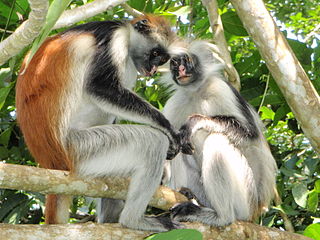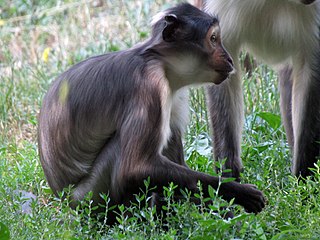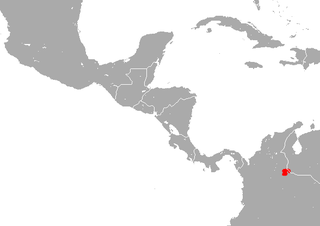
Mackerel is a common name applied to a number of different species of pelagic fish, mostly from the family Scombridae. They are found in both temperate and tropical seas, mostly living along the coast or offshore in the oceanic environment.
Calyptommatus is a genus of Brazilian lizards in the family Gymnophthalmidae.

The guenons are Old World monkeys of the genus Cercopithecus. Not all members of this genus have the word "guenon" in their common names; also, because of changes in scientific classification, some monkeys in other genera may have common names that include the word "guenon". Nonetheless, the use of the term guenon for monkeys of this genus is widely accepted.

Red colobuses are Old World monkeys of the genus Piliocolobus. It was formerly considered a subgenus within the genus Procolobus, which is now restricted to the olive colobus. They are closely related to the black-and-white colobus monkeys, and some species are often found in groups with the blue monkey. The western red colobus is frequently hunted by the common chimpanzee.

The white-eyelid mangabeys are African Old World monkeys belonging to the genus Cercocebus. They are characterized by their bare upper eyelids, which are lighter than their facial skin colouring, and the uniformly coloured hairs of the fur. The other two genera of mangabeys, Lophocebus and Rungwecebus, were once thought to be very closely related to Cercocebus, so much so that all the species were placed in one genus, but Lophocebus and Rungwecebus species are now understood to be more closely related to the baboons in genus Papio, while the Cercocebus species are more closely related to the mandrill.

The bronze sprite, also known as the black-gilded pipistrelle, is a species of vesper bat found in China, India, Myanmar, and Nepal.

The tropical small-eared shrew is a very small mammal of the family Soricidae. The species is found in the eastern highlands of Chiapas, Mexico, and parts of Belize and Guatemala. Until recently, it was considered a subspecies of the North American least shrew, but it has gained species status. Its relationship with the Central American least shrew remains to be studied.

The Nusatenggara short-nosed fruit bat is a species of megabat within the family Pteropodidae found in Indonesia. It has three subspecies:

The Tamá small-eared shrew is a species of mammal in the family Soricidae. It is known from the Cordillera Oriental of Colombia and the Páramo de Tamá of western Venezuela, where it has been found primarily in cloud forest at elevations between 2,380 and 3,330 m. Its range includes Venezuela's El Tamá National Park. The closest relatives of the species are C. meridensis and C. thomasi.
Calyptommatus leiolepis is a species of lizard in the family Gymnophthalmidae. It is endemic to Brazil.
Calyptommatus nicterus is a species of Squamata in the family spectacled tegus. They are found in the Neotropics of Brazil. They rely on running to move around. This is species of lizard in the family Gymnophthalmidae. It is endemic to Brazil.
Calyptommatus sinebrachiatus is a species of lizard in the family Gymnophthalmidae. It is endemic to Brazil.
Calyptommatus frontalis is a species of lizard in the family Gymnophthalmidae. It is endemic to Brazil.








